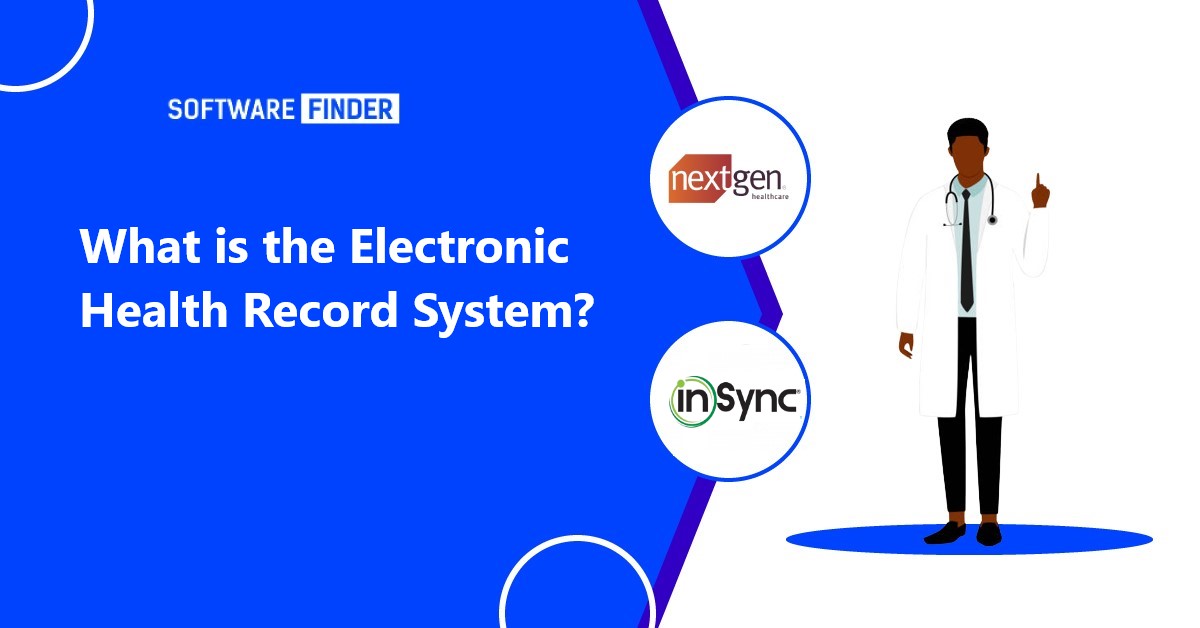What is Electronic Health Record System?

Electronic health records (EHR) are modernized and upgraded healthcare software with many tools to serve practitioners, admin staff, and patients. The number of features EHRs provide quality services to replace traditional paperwork with digitized healthcare solutions. Moreover, the options of EHRs varying from NextGen EHR to InSync EHR come with various electronic health record choices.
In this article, we are emphasizing the different aspects of EHRs to further detail what an electronic health record system is!
What is an Electronic Health Record?
EHRs, or electronic health records, assist with digitally recording medical records, but additionally, they feature expanded services. It provides superior and cutting-edge resources that facilitate the complete digitization of previously paper-based processes, from data collection and transmission to monitoring and reporting. Its programs include NextGen EHR, InSync EHR, and Valant EHR, to name a few.
A patient’s electronic health record (EHR) can include several sorts of information, including the patient’s medical history, key vitals, diagnoses, medications, immunization dates, allergies, laboratory findings, and imaging scans. Information from exercise trackers and other wearables, as well as insurance data, can be included.
A clinic that uses electronic health records is better able to organize a patient’s care by coordinating with other practitioners. The use of EHRs facilitates communication between medical professionals involved in a given patient’s care. If a patient moves out of the area and needs to locate a new physician, they also ensure that no information is lost. These features make electronic health records (EHRs) extremely patient-centric and useful for sharing patient data safely and smoothly.
Lastly, the interchangeable use of the words “EMR” and “EHR” may have confused you about whether both are the same or not. Although both EMR and EHR refer to healthcare systems, EHR is often regarded as a more advanced healthcare system as compared to EMR. However, both programs have their perks and leverage points.
How Do You Choose Electronic Health Record Software?
Before we get into a few electronic health record systems, we think sharing the tips for choosing EHR will help you quickly understand which system is better for you.
There might be different tips for choosing EHR; the following points might be a good, quick, and brief guide when searching for EHR software for your healthcare settings.
- To know what to search for in EHRs, you must first identify and evaluate your clinical needs. It will assist you in finding out what you must be looking for.
- Make a detailed plan for how much money you can spend on electronic health record software. It will help you to look for only budget-centric products.
- Conduct a clinical workflow study with your team to determine which tools are essential, helpful, and desirable. It will focus your attention on those systems that value your preferred tools.
- Compare various narrowed options EHRs based on their deployment and training metrics. It will let you know whether it is suitable for your clinical settings or not.
- When looking for the best EHR, it’s also essential to consider the software’s customer support options and available channels.
What Are Leading Electronic Health Record Systems?
Electronic health records available in the market have exceeded the figure of 200+ options. It might be daunting for new users to pick a suitable EHR. Choosing EHR software requires proper attention to make the choice. However, here we are sharing a few names of leading electronic health record systems, which might give you a starting idea for exploring the competitive EHR market.
NextGen EHR:
Over the past two decades, thousands of doctors and nurses have used NextGen EHR to increase efficiency in their practices and care for patients. Many doctors favor NextGen EHR because of its user-friendly interface, adaptability in terms of integration, and dependable deployment on Windows and Mac, as well as mobile app services made for independent medical offices.
NextGen EHR also provides monitoring tools & dashboards, automates insurance eligibility, allows patients to make appointments, request refills, set up telehealth visits, and facilitates communication between the care team through direct messaging and the sharing of referrals. NextGen EHR allows providers to input their session notes into the clinical storage via touch, voice, or typing.
InSync EHR:
InSync EHR integrated electronic health records (EHR), practice management (PM), invoicing, and revenue cycle management (RCM) into a single platform. It’s very adaptable, with features that span from behavioral therapy to primary care, and it’s constantly being improved with new additions.
Several clinical reviewers have praised InSync EHR for its ability to centralize various administrative and clinical functions, including billing, charting, scheduling appointments, telehealth services, and patient data. Medical practices can benefit from InSync Software’s suite of options for managing and streamlining their operations, from patient scheduling to document management.
Valant EHR:
Valant EHR is a cloud-based software suite that helps professionals in the mental health industry improve workflow, reduce paperwork, and expand their businesses reach. The Valant EHR system is built to meet mental health clinics’ clinical, financial, and administrative requirements while remaining secure, reliable, and scalable. Due to its design structure, it does not require the tools or regular upkeep of conventional on-premise systems.
Valant EHR is compatible with various external integration programs, such as laboratory networks, insurance providers, and medical device manufacturers. This integration allows clinical information to move freely, and operational processes can be streamlined.
How Can You Leverage EHRs?
Electronic health records have various benefits which users can leverage to uplift their clinical practices. But we will share quick, lesser-known, top-notched leverages of EHRs.
- When it comes to bettering the patient experience, patient platforms are crucial. Easy two-way clinical communication is optimized. They can access various web services as a result. For instance, NextGen EHR is well-known for its user-friendly interface and features a patient gateway that is both streamlined and efficient.
- The telehealth elements of InSync EHR are just one example of how telemedicine tools are now standard on most electronic health records. Now that patients can schedule virtual appointments with their doctors, they can get the treatment they need more easily, regardless of their physical location.
- Current EHRs, such as NextGen EHR, focus on the patient and are highly adaptable. They can be modified to fit the specific requirements of practitioners and office personnel.
- The ensured safety of electronic health records is another leveraging aspect. There are a variety of authorization tools for protecting sensitive data in electronic health records. Moreover, the monitored and authorized security standards are adhered to by the majority of EHRs, which highlight enhanced and full data protection. For instance, NextGen EHR and InSync EHR are just two leading programs complying with security standards.
Final Words:
Regardless of the technology and clinical terms we use to define EHRs, in the simplest words, it is a must-have program for doctors. It not only brings a few optional advantages; it upgrades the whole healthcare working standard. Moreover, Software Finder can provide quick demos or expert calls if you need assistance.



